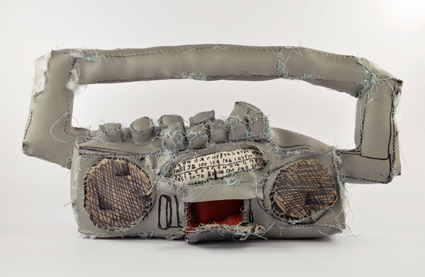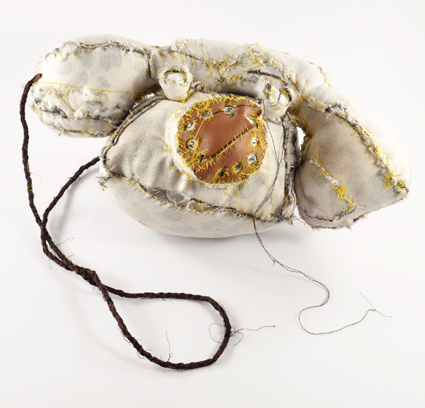 |
Terry Williams, Stereo 2011, vinyl fabric, cotton, stuffing and fibre-tipped pen, private collection, Melbourne |
As Sarah Boxer put it in The Atlantic (“The Rise of Self-Taught Artists”): to be an ‘outsider’ requires identification from an ‘insider’—and immediately, the outsider becomes an insider. Everyday Imagining: New Perspectives on Outsider Art, at Melbourne’s Ian Potter Museum of Art, offered a welcome opportunity both to reflect on the assumptions that have underpinned Outsider Art, and to experience the work of seven Australian and New Zealand “outsider artists.”
As curator Joanna Bosse outlines in her catalogue essay, the antecedent to Outsider Art is generally acknowledged to be the classification ‘art brut,’ coined in the mid-1940s by French artist Jean Dubuffet. For him, art brut described a kind of primal, unsullied creativity; he was especially interested in the mentally ill, seeing them as being beyond societal and cultural influence. Bosse is keen to debunk this view, and has selected artists for this exhibition whose work, she says, “convincingly argues against the idea that interiority lies at the heart of their practice.” These seven artists, she points out, are very actively engaged with the external world, and their work, far from displaying a romantically-conceived solipsism, expresses their deep interest in everyday objects and experiences.
 |
Terry Williams, Telephone |
Jonathan Griffin has posed the question: is Outsider Art “a reactionary throwback to anachronistic ideas of artistic genius, suffering and dysfunction?” Similar tropes include that of the ‘unwell’ or disabled artist for whom art-making is a form of ‘medicine’ or ‘therapy.’ Sarah Boxer mentions the case of Adolf Wölfli, a late 19th century Swiss ‘outsider’ whose compulsive drawing “calmed him down.” In Everyday Imaginings, Bosse points—without didacticism—to the possibility of such a motivation in the work of New Zealander Martin Thompson, whose intricate, patterned works in felt-tipped pen, created by filling in 1mm squares on large sheets of graph paper, are so flawlessly executed that at first glance they appear digitally created.
Thompson’s symmetrical, monochromatic designs shimmer like snowflakes or starfields. Different impressions emerge from them like magic-eye pictures, or appear cross-hatched like thick embroidery. They map out planes of not only obsessive, perhaps meditative markings, but of myriad subtleties as well—fine deepenings or lightenings of colour that betray the hand of the artist, his body and his attention in the moment of making. One work seems to have been excavated for the viewer, with one broad edge of the page left uncoloured and finger-smudged.
Like Williams’ fabric sculptures, Thompson’s intricate grids remind me of the notion of ‘women’s work’—that of sewing, crafting, embroidery; in Thompson’s, a pixellated crafting that precedes the digital. Indeed, in the USA, Outsider Art has at times been classified alongside or within ‘folk art,’ and it’s tempting to wonder whether these tactile, intimate engagements, privileging the domestic or the introspective over grand themes, unwittingly undergo some subtle conflation with the feminine, that other great ‘outsider’ category. I’m reminded too of Ann Cvetkovich’s writings on crafting as habitual counter to the insanity of Western modernity, in her book Depression: A Public Feeling.
Equally, it seems that these artists just do what artists always do: shaping form out of chaos (see Elizabeth Grosz’s Chaos, Territory, Art); exploring representation, abstraction, topography. Both Thompson’s patternings and Andrew Blythe’s paintings on paper map out distinct landscapes, two-dimensional architectures whose regularities and inconsistencies play off one another. Blythe’s paintings, created entirely from repetitions of the X symbol and the word ‘no,’ seem to deliver a message, up close, but at a distance have the simultaneously 2D/3D shimmer seen and felt in some Aboriginal dot paintings. Lisa Reid and Jack Napthine both depict bodies and objects: Reid in stripped-down life drawings that relay the character of her models with cartoonish accuracy; and Napthine in a long and colourful mural, both map and narrative, that includes the names of places and events woven around bright drawings of light globes and locks. Where Reid and Napthine bring ‘reality’ into sharp, lean focus, Julian Martin and Kellie Greaves move in the opposite direction, abstracting familiar objects to create colourful paintings that leave the ‘thing’ behind, or obscured, focusing instead on colour and form.
Whether or not there is really an ‘inside’ or an ‘outside,’ Everyday Imagining shines a well-focused light on the work of these seven artists and opens up a productive space for exploring the edges and conflicts of the notion of Outsider Art. Perhaps, as Museum of Everything founder James Brett has suggested, we are all in any case on one ‘spectrum’ or another and creativity is “a version of dysfunction.” Personally, I’m partial to Louise Bourgeois’ famous words: “Art is a guaranty [sic] of sanity”.
Everyday Imagining: New Perspectives on Outsider Art, Ian Potter Museum of Art, University of Melbourne, 1 Oct, 2014-18 Jan, 2015
RealTime issue #125 Feb-March 2015 pg. 47
© Urszula Dawkins; for permission to reproduce apply to [email protected]








 back
back